The akikiki is currently North America’s rarest bird, with fewer than 10 individuals remaining as of 2023. The ivory-billed woodpecker, though likely extinct, has had no confirmed sightings since 1987 and remains unverified as such. Meanwhile, the California condor, once extinct in the wild, has been successfully reintroduced, with 369 individuals recorded in the wild by 2025.
This article highlights some of the rarest and most endangered birds still found across North America, including the United States, Canada, Mexico, the Caribbean, and Central America. Each species included is either classified as endangered or faces significant threats in its natural habitat. While sightings of some birds remain uncertain, these species represent the most at-risk populations still found in the wild today.
Golden-cheeked warbler (Setophaga chrysoparia)
- Conservation status: Endangered.
- Estimated population: Uncertain, estimates range from 11,600 to over 200,000 individuals.
- Known range: Central Texas (Edwards Plateau); winters in Mexico and Central America.
- Main threats: Habitat loss, fragmentation, urban development, cowbird parasitism.

The golden-cheeked warbler is a migratory songbird that breeds exclusively in central Texas, relying on Ashe juniper-oak woodlands for nesting. Unlike many other warblers, it is highly specialized, requiring mature juniper bark to build its nests. Since the 1960s, urban expansion, agriculture, and logging have significantly reduced and fragmented its habitat. Although population estimates vary widely, the species was listed as Endangered in 1990 due to severe habitat loss rather than direct population decline. Recent studies suggest the population may be larger than previously thought, leading to a potential downlisting to Threatened, but continued habitat degradation keeps the species at risk.
The warbler remains highly conservation-dependent, as its breeding areas continue to shrink due to urban sprawl, land clearing, and infrastructure projects. Additionally, brown-headed cowbirds parasitize nests, further lowering reproductive success. While conservation efforts, including protected reserves and habitat management, have helped stabilize numbers in some regions, the warbler’s reliance on a rare and declining habitat means that without continued protection, the species could face renewed declines.
Kittlitz’s murrelet (Brachyramphus brevirostris)
- Conservation status: Near Threatened.
- Estimated population: Approximately 30,000 mature individuals.
- Known range: Coastal regions of Alaska and eastern Siberia.
- Main threats: Habitat loss due to glacial retreat, oil spills, and human disturbance.

The Kittlitz’s murrelet is a small seabird inhabiting the coastal waters of Alaska and eastern Siberia. Unlike many seabirds, it nests solitarily on barren, rocky ground near glaciers or alpine areas, often far inland. This species is closely associated with glacial environments, feeding primarily in waters near tidewater glaciers. Recent studies have indicated that while some populations have experienced declines, others appear stable or are recovering, leading to its current classification as Near Threatened.
Primary threats to the Kittlitz’s murrelet include habitat loss due to glacial retreat driven by climate change, oil spills, and disturbances from increased boat traffic. The Exxon Valdez oil spill in 1989, for instance, is estimated to have killed about 5-10% of the global population. Conservation efforts are ongoing, focusing on habitat protection and minimizing human disturbances in critical areas.
Honduran emerald (Amazilia luciae)
- Conservation status: Vulnerable.
- Estimated population: Approximately 10,000 to 20,000 mature individuals.
- Known range: Endemic to Honduras.
- Main threats: Habitat loss due to agricultural expansion and human development.

The Honduran emerald is a vibrant hummingbird species endemic to Honduras, making it the country’s only bird species found exclusively within its borders. The species inhabits dry, open-canopy deciduous thorn forests and scrublands, primarily in intermontane valleys at elevations between 200 and 1,200 meters. Notable populations exist in the Aguan Valley and regions within the departments of Santa Bárbara, Cortés, Yoro, and Olancho.
Despite its relatively recent rediscovery in 1988 after decades without confirmed sightings, the Honduran emerald faces significant conservation challenges. The primary threat to its survival is habitat loss, driven by agricultural expansion, cattle ranching, and human development, leading to the degradation and fragmentation of its specialized dry forest habitat. Conservation efforts are crucial to protect the remaining habitat and ensure the species’ survival.
Three-wattled bellbird (Procnias tricarunculatus)
- Conservation status: Vulnerable.
- Estimated population: 5,000-15,000 mature individuals.
- Known range: Highlands of Costa Rica and western Panama; migratory populations in Honduras and Nicaragua.
- Main threats: Habitat loss due to deforestation and agricultural expansion.

The three-wattled bellbird is a distinctive species native to Central America, renowned for its exceptionally loud, bell-like calls. Males are notable for their chestnut-brown bodies, white heads and throats, and the presence of three elongated, black wattles hanging from the base of their beaks. Females, in contrast, exhibit olive plumage with yellowish streaked underparts and lack wattles. This sexual dimorphism is pronounced, with males using their striking appearance and calls during mating displays.
The species primarily inhabits montane cloud forests at elevations ranging from 1,200 to 2,100 meters, though it can occasionally be found at lower elevations. Its diet consists mainly of fruits from trees in the Lauraceae family, such as avocados, playing a crucial role in seed dispersal within its ecosystem. The three-wattled bellbird is currently classified as Vulnerable, with a declining population due to ongoing habitat loss. Conservation efforts are focused on preserving remaining cloud forest habitats and promoting sustainable land-use practices to ensure the species’ survival.
Piping plover (Charadrius melodus)
- Conservation status: Near Threatened.
- Estimated population: Around 7,700 mature individuals.
- Known range: Breeds in the Atlantic Coast, Great Lakes, and Northern Great Plains; winters along the Gulf of Mexico, Southern Atlantic Coast, and the Caribbean.
- Main threats: Habitat loss, human disturbance, predation, climate change.

The piping plover is a small shorebird that nests on sandy beaches and sandflats along the Atlantic Coast, Great Lakes, and Northern Great Plains. It winters along the Gulf of Mexico, the Southern Atlantic Coast, and parts of the Caribbean. The species’ cryptic coloration allows its nests and chicks to blend into the sand, offering protection from predators but making them highly vulnerable to human disturbance. The Great Lakes population, one of the rarest breeding bird populations in North America, is federally Endangered and remains critically small despite conservation efforts.
Piping plovers continue to face habitat destruction, increased coastal development, and predation by foxes, raccoons, and feral cats. Rising sea levels and stronger storms caused by climate change further threaten their nesting grounds. Conservation programs, including nest protection, habitat restoration, and public education, have helped stabilize some populations, but localized declines persist, particularly in the Great Lakes region, where active management remains essential for survival.
Kirtland’s warbler (Setophaga kirtlandii)
- Conservation status: Near Threatened.
- Estimated population: Approximately 2,245 pairs as of 2021.
- Known range: Michigan, Wisconsin, Ontario (breeding); Bahamas (wintering).
- Main threats: Habitat loss, fire suppression, cowbird parasitism.

The Kirtland’s warbler is a small migratory songbird that nests almost exclusively in young jack pine forests. Historically, these habitats were naturally regenerated by wildfires, which opened jack pine cones and facilitated new growth. However, human-induced fire suppression significantly reduced the availability of suitable breeding areas, contributing to the species’ decline. Additionally, brood parasitism by brown-headed cowbirds further threatened the warbler’s reproductive success, as cowbird chicks often outcompete warbler chicks for food.
By the 1980s, the Kirtland’s warbler population had plummeted to around 200 individuals. Intensive conservation efforts, including habitat management through controlled burns and planting, as well as cowbird control programs, have led to a remarkable recovery. The population has now surpassed the initial recovery goal of 1,000 pairs, with an estimated 2,245 pairs recorded in 2021.
Despite this success and its removal from the U.S. Endangered Species List in 2019, the Kirtland’s warbler remains conservation-reliant, requiring ongoing habitat management and monitoring to ensure its continued survival. Emerging threats, such as climate change affecting its wintering habitats in the Bahamas, underscore the need for sustained conservation efforts.
Florida scrub-jay (Aphelocoma coerulescens)
- Conservation status: Vulnerable.
- Estimated population: Approximately 7,000 mature individuals.
- Known range: Endemic to Florida, inhabiting oak scrub ecosystems.
- Main threats: Habitat loss, fire suppression, habitat fragmentation.
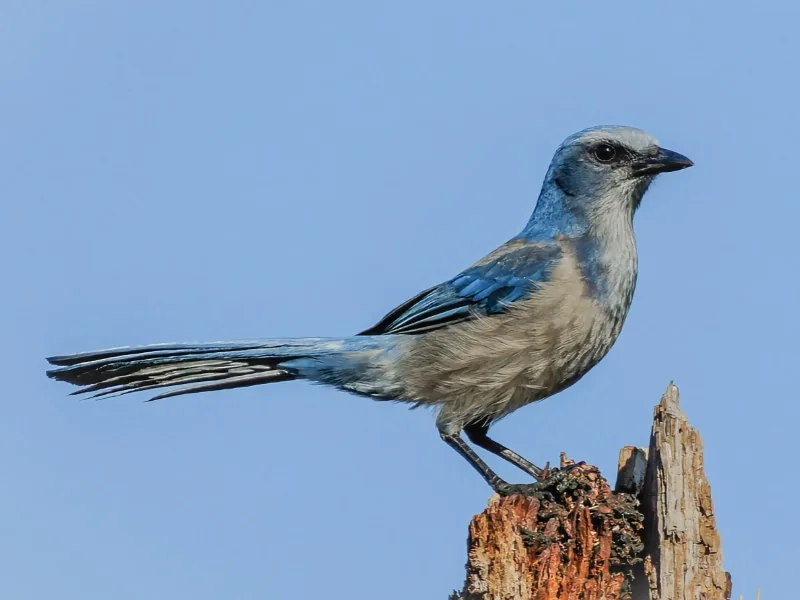
The Florida scrub-jay is the only bird species endemic to Florida, residing exclusively in the state’s diminishing oak scrub habitats. These environments are characterized by well-drained, sandy soils and low-growing oaks, maintained by periodic wildfires. Historically, natural fires played a crucial role in sustaining these ecosystems by preventing overgrowth. However, extensive fire suppression and urban development have led to habitat degradation and fragmentation, significantly impacting scrub-jay populations.
Population estimates indicate a decline from historical numbers of around 40,000 individuals to current figures between 7,700 and 9,300. This reduction is primarily due to the loss and alteration of scrub habitats. Conservation efforts focus on habitat preservation, restoration, and the implementation of prescribed burns to mimic natural fire regimes, which are essential for maintaining suitable living conditions for the Florida scrub-jay.
Jamaican blackbird (Nesopsar nigerrimus)
- Conservation status: Endangered.
- Estimated population: Approximately 1,500 to 5,000 adult individuals.
- Known range: Endemic to Jamaica, primarily in the Blue and John Crow Mountains and Cockpit Country.
- Main threats: Habitat loss due to deforestation, bauxite mining, and agriculture.

The Jamaican blackbird is an endangered species endemic to Jamaica, primarily inhabiting the Blue and John Crow Mountains and Cockpit Country. This bird thrives in wet montane forests rich in epiphytes, such as bromeliads and mosses, which are crucial for its foraging activities. Its plumage is entirely black with a slight blue gloss, and it has a slender, sharp bill adapted for probing into tree bark and epiphytes to extract insects and other small invertebrates.
The Jamaican blackbird faces significant threats from habitat loss due to deforestation, bauxite mining, and agricultural expansion. These activities lead to the removal of mature trees that support the epiphytes essential for the bird’s foraging. Conservation efforts are critical to protect the remaining habitats and ensure the survival of this unique species.
Ashy storm petrel (Hydrobates homochroa)
- Conservation status: Endangered.
- Estimated population: Approximately 3,500 to 6,700 mature individuals.
- Known range: Breeds on coastal islands off California and northern Baja California.
- Main threats: Predation by introduced species, habitat degradation, pollution, climate change.

The ashy storm petrel is a small, nocturnal seabird endemic to the California Current System, breeding on 17 islands off the coasts of California and northern Baja California, Mexico. Notably, about half of the global population nests on the Farallon Islands near San Francisco. These birds prefer nesting in rock crevices and burrows, returning to their colonies exclusively at night. Their elusive nature and inaccessible nesting sites make population monitoring challenging.
The primary threats to the ashy storm petrel include predation by introduced species such as rats and feral cats, which have been introduced to their breeding islands. Additionally, habitat degradation due to human activities, pollution, and the impacts of climate change, such as rising sea levels and ocean acidification, pose significant risks. The species’ limited range and small population size make it particularly vulnerable to localized disasters, like oil spills. Conservation efforts focus on invasive species control, habitat protection, and pollution mitigation to enhance the species’ viability.
Yellow-headed amazon (Amazona oratrix)
- Conservation status: Endangered.
- Estimated population: Approximately 4,000-4,500 mature individuals.
- Known range: Mexico and northern Central America.
- Main threats: Habitat loss, poaching for the pet trade.
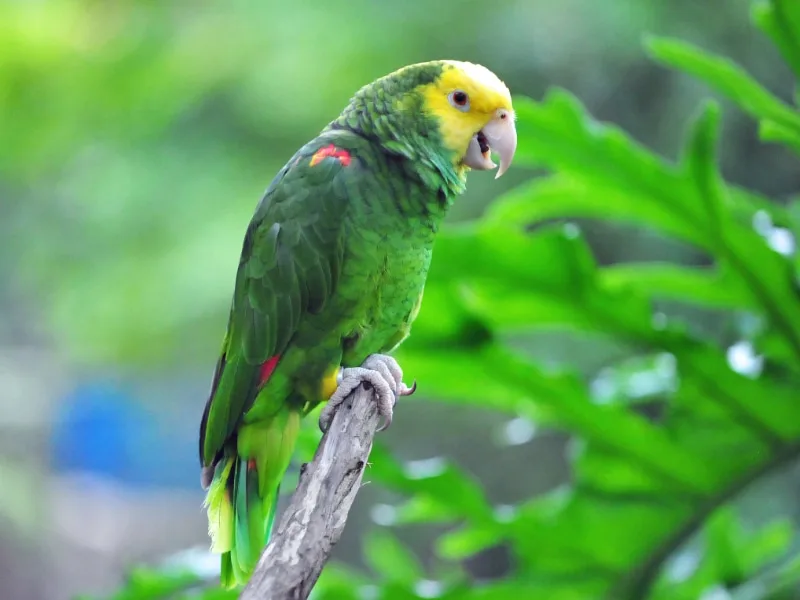
The yellow-headed amazon is one of the most recognizable parrots native to Mexico and northern Central America, known for its striking yellow head and remarkable vocal abilities. Once abundant across its range, the species has suffered a severe population decline, primarily due to deforestation and illegal capture for the pet trade. Between the 1970s and 1994, wild numbers fell by nearly 90%, and continued declines have led to its current classification as Endangered. The species is now mainly restricted to fragmented populations in Mexico, with small numbers in Belize, Guatemala, and Honduras.
Conservation efforts focus on habitat protection and enforcement against illegal poaching, as well as initiatives to maintain protected reserves. The yellow-headed amazon is also listed under CITES Appendix I, which bans international trade in wild-caught individuals. Despite these efforts, illegal trafficking remains a major threat, with many birds still being captured for the pet trade. While feral populations have been established in cities like Los Angeles and Stuttgart, the survival of wild populations remains uncertain without stronger conservation measures.
Gunnison sage-grouse (Centrocercus minimus)
- Conservation status: Endangered.
- Estimated population: 3,220 to 3,950 individuals as of 2023.
- Known range: Southwestern Colorado, Southeastern Utah.
- Main threats: Habitat loss, drought, disease, human disturbance.
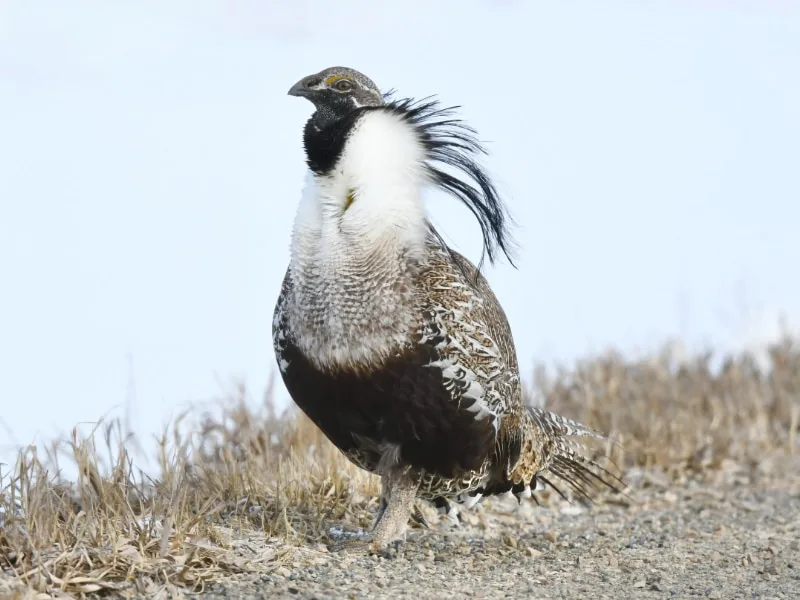
The Gunnison sage-grouse is one of newly discovered bird species, officially described in 2000 after being distinguished from the greater sage-grouse. Smaller in size and with unique courtship behaviors, it depends on sagebrush habitat year-round for food and cover. Historically, this species was found across New Mexico, northeastern Arizona, Colorado, and Utah, but due to habitat loss, fragmentation, and human disturbances, its range has dramatically shrunk. Today, it survives in only seven isolated populations, with the largest group in Gunnison Basin, Colorado.
Its small, fragmented population makes it highly vulnerable to environmental threats such as drought, disease, and land-use changes. Energy development, agriculture, and poorly managed grazing continue to degrade its remaining habitat, while human-made barriers like roads and fences disrupt its movement. Conservation efforts have been in place since the 1990s, but without sustained protection and habitat restoration, the species’ long-term survival remains uncertain.
Bahama oriole (Icterus northropi)
- Conservation status: Endangered.
- Estimated population: Approximately 2,500-5,000 mature individuals.
- Known range: Andros Island, Bahamas.
- Main threats: Habitat loss, invasive predators, palm disease, nest parasitism.

The Bahama oriole is a rare and range-restricted songbird found exclusively on Andros Island in the Bahamas, after disappearing from Abaco in the 1990s. Once believed to rely primarily on coconut palms for nesting, recent research has shown that the species also nests in native pine forests and broadleaf habitats, expanding conservation priorities. Despite this broader habitat use, the total population remains small, and its survival is closely linked to continued habitat protection.
Major threats include predation by introduced species (such as rats and feral cats), nest parasitism by the shiny cowbird, and the spread of lethal yellowing disease, which affects coconut palms. Conservation efforts focus on habitat protection, invasive species control, and ongoing research to better understand the species’ ecological needs. While recent surveys have revealed a larger population than previously estimated, the Bahama oriole remains one of the rarest birds in North America, requiring sustained conservation efforts for its long-term survival.
Maroon-fronted parrot (Rhynchopsitta terrisi)
- Conservation status: Endangered.
- Estimated population: Fewer than 2,000 mature individuals.
- Known range: Sierra Madre Oriental, northeastern Mexico.
- Main threats: Habitat loss, deforestation, overgrazing.

The maroon-fronted parrot is a striking, large parrot endemic to northeastern Mexico, primarily found in the Sierra Madre Oriental. It is predominantly dark green, with a maroon forehead and eye stripe, red shoulder patches, and dark wing and tail undersides visible in flight. This species inhabits high-altitude pine, mixed conifer, and pine-oak forests, where it forages primarily on pine seeds. Unlike many parrots, it nests in limestone cliff faces, forming large breeding colonies that lay eggs between July and August.
With an estimated 2,500-3,000 birds remaining, the maroon-fronted parrot is classified as Endangered, facing significant threats from habitat destruction, deforestation, and overgrazing by livestock. The loss of mature pine forests reduces both nesting sites and food availability. Conservation efforts focus on habitat preservation, reforestation, and environmental education programs to protect this species and its fragile ecosystem. Continued action is crucial to ensuring the survival of this unique highland parrot.
Thick-billed parrot (Rhynchopsitta pachyrhyncha)
- Conservation status: Endangered.
- Estimated population: Approximately 800-1,500 mature individuals.
- Known range: Endemic to Mexico’s Sierra Madre Occidental; historically found in the southwestern United States.
- Main threats: Habitat loss due to logging, illegal pet trade, climate change.

The thick-billed parrot is a vibrant, medium-sized parrot native to the high-elevation conifer forests of Mexico’s Sierra Madre Occidental. Recognizable by its bright green plumage, prominent red forehead, and shoulder patches, this species is uniquely adapted to cooler climates, earning it the nickname “snow parrot.” Historically, the thick-billed parrot’s range extended into the southwestern United States, including Arizona and New Mexico, but it has been extirpated from these areas since the 1930s.
Major threats to its survival include habitat loss due to logging, which reduces available nesting sites and food sources, as well as the illegal pet trade. Conservation efforts are ongoing, focusing on habitat protection and potential reintroduction programs to restore populations in their former U.S. range.
Great green macaw (Ara ambiguus)
- Conservation status: Critically Endangered.
- Estimated population: Fewer than 1,000 mature individuals.
- Known range: Lowland tropical forests from Honduras through western Colombia and Ecuador
- Main threats: Habitat loss due to deforestation and illegal capture for the pet trade.

The great green macaw is one of the largest parrot species, recognized for its vibrant plumage and strong association with tropical forests in Central and South America. Historically, this macaw inhabited a broad range from Honduras to western Ecuador. However, extensive deforestation and habitat fragmentation have led to significant population declines, resulting in its current classification as Critically Endangered.
Recent conservation efforts have shown promising results. In Costa Rica, for instance, the population increased from 330 to 550 individuals (a 67% rise since 2021), marking the largest number ever recorded in the country. Despite these positive trends, the global population remains precariously low, with estimates around 1,000-1,500 individuals. The primary threats to the species include ongoing habitat destruction and illegal capture for the pet trade. Continued conservation initiatives are essential to ensure the survival of this magnificent bird.
Akekee (Loxops caeruleirostris)
- Conservation status: Critically Endangered.
- Estimated population: 638 individuals in the wild, as of 2021.
- Known range: Alaka’i Plateau, Kaua’i, Hawaii.
- Main threats: Avian malaria, habitat loss, climate change.

The akeke’e is a small Hawaiian honeycreeper endemic to the Alaka’i Plateau on Kaua’i, where it inhabits high-elevation ‘ohi’a forests. Recognizable by its greenish-yellow plumage, black facial mask, and bluish bill, the species uses its slightly crossed bill to pry open leaf buds in search of insects and nectar. Unlike many other honeycreepers, the akeke’e is non-territorial and moves widely across its habitat, making conservation efforts challenging.
Once common, the akeke’e population has declined rapidly since the early 2000s, primarily due to avian malaria transmitted by invasive mosquitoes. Climate change has allowed mosquitoes to expand into higher elevations, where they historically did not exist. As of 2021, an estimated 638 individuals remained in the wild, with just seven in captivity. Scientists project that the species could go extinct between 2023 and 2034, with 2028 as the most likely scenario. Conservation efforts focus on mosquito control, habitat protection, and disease prevention, but the species’ stress-prone nature in captivity has prevented successful breeding programs so far.
Short-crested coquette (Lophornis brachylophus)
- Conservation status: Critically Endangered.
- Estimated population: 250-900 mature individuals.
- Known range: Sierra Madre del Sur, Guerrero, Mexico.
- Main threats: Deforestation, agricultural expansion, habitat degradation.

The short-crested coquette is a tiny, elusive hummingbird endemic to the Sierra Madre del Sur in Guerrero, Mexico. Males are recognized by their short, rufous crest and orange cheek tufts tipped with green, while females lack these ornate features. Both sexes have emerald green upperparts and pale cinnamon underparts. This species inhabits humid evergreen forests, pine-oak woodlands, and shaded coffee plantations at elevations between 900 and 1,800 meters, where it primarily feeds on nectar and small arthropods.
With an estimated population of fewer than 1,000 mature individuals, the short-crested coquette is classified as Critically Endangered. Habitat destruction due to deforestation, agricultural expansion, and illegal crop cultivation continues to threaten its survival. Conservation efforts focus on protecting remaining habitat and promoting sustainable land-use practices. Due to its restricted range and ongoing habitat loss, urgent conservation actions are needed to prevent further population decline.
Whooping crane (Grus americana)
- Conservation status: Endangered (IUCN).
- Estimated population: 600 individuals in the wild, as of 2020.
- Known range: Canada, USA (Texas, Wisconsin, Louisiana, Florida).
- Main threats: Habitat loss, power line collisions, illegal hunting.

The whooping crane is the tallest bird in North America, standing nearly five feet tall with a wingspan of over seven feet. Historically, it bred in Canada and the northern United States, migrating to winter in Mexico, Texas, and the Atlantic Coast. However, by the early 20th century, overhunting and habitat destruction caused a catastrophic decline, leaving only 15 wild individuals by 1941.
Since then, intensive conservation efforts have helped the population recover. Captive breeding programs, habitat protection, and reintroduction projects have gradually increased numbers. The primary wild population now breeds in Wood Buffalo National Park (Canada) and winters in Aransas National Wildlife Refuge (Texas, USA). Additional reintroduced populations exist in Wisconsin, Louisiana, and Florida, where some birds are guided on migration routes using ultralight aircraft. Despite these efforts, the species remains highly vulnerable, facing ongoing threats from habitat loss, power line collisions, and illegal hunting.
Ridgway’s hawk (Buteo ridgwayi)
- Conservation status: Critically Endangered.
- Estimated population: 400-500 mature individuals.
- Known range: Endemic to Hispaniola (Haiti and the Dominican Republic).
- Main threats: Habitat loss, human persecution, nest parasitism, electrocution.
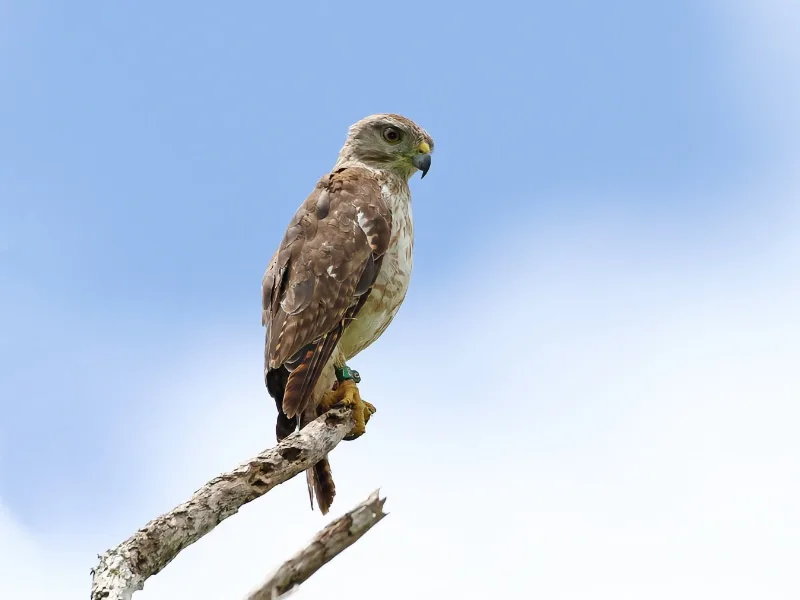
The Ridgway’s hawk is a small raptor endemic to the island of Hispaniola, encompassing both Haiti and the Dominican Republic. Adults are characterized by a gray hood, barred orange underparts, and a grayish-brown back. Historically widespread across the island, its range has now diminished primarily to the Los Haitises National Park in the Dominican Republic.
With an estimated population of fewer than 500 adult individuals, the Ridgway’s hawk faces several critical threats. These include habitat destruction, human persecution due to misconceptions about poultry predation, nest parasitism by flies, and electrocution from power lines. Conservation efforts, such as reintroductions in Punta Cana and public education campaigns, have shown promise in stabilizing and increasing the population. However, continued dedication is essential to ensure the species’ long-term survival.
California condor (Gymnogyps californianus)
- Conservation status: Critically Endangered.
- Estimated population: 369 individuals in the wild, as of 2025.
- Known range: California, Arizona, Utah, and Baja California, Mexico.
- Main threats: Lead poisoning, microtrash ingestion, habitat modification, and avian diseases.

The California condor is the largest land bird in North America, boasting a wingspan exceeding nine feet and weighing up to 20 pounds. Historically, this scavenger ranged across the western United States, including Arizona, Utah, Colorado, Wyoming, Idaho, Montana, Oregon, and California, feeding primarily on large mammal carcasses. However, by 1987, due to factors such as habitat destruction, poaching, and lead poisoning, the species became extinct in the wild. The remaining individuals were captured to initiate a captive-breeding program aimed at species recovery.
Through intensive conservation efforts, including captive breeding and reintroduction programs, the California condor population has gradually increased. As of 2025, the total population reached 566 individuals, with 369 living in the wild. Reintroduced populations now inhabit parts of California, Arizona, Utah, and Baja California, Mexico. Despite these successes, the species remains critically endangered, facing ongoing threats from lead poisoning (primarily due to ingesting spent lead ammunition) microtrash ingestion, habitat modification, and diseases such as avian influenza. Continued conservation efforts are essential to ensure the species’ survival and recovery.
Grenada dove (Leptotila wellsi)
- Conservation status: Critically Endangered.
- Estimated population: Fewer than 150 individuals.
- Known range: Endemic to Grenada, Lesser Antilles.
- Main threats: Habitat loss, fragmentation, and predation by introduced species.

The Grenada dove is a medium-sized bird endemic to the island of Grenada in the Lesser Antilles. Recognized as Grenada’s national bird, it is distinguished by its stout body, reddish-brown or olive mantle, white-greyish crown and forehead, light pinkish-cinnamon breast and neck, and whitish belly and flanks. This dove primarily inhabits dry coastal forests in the southwest and west of the island, where it forages on the ground for seeds. Its call is a drawn-out, low, plaintive “Hooooooo,” loudest near the start.
With an estimated population of fewer than 150 individuals, the Grenada dove is classified as Critically Endangered. The species faces significant threats from habitat loss and fragmentation due to development and agriculture, as well as predation by introduced species. Conservation efforts are crucial to protect the remaining population and its habitat.
Imperial amazon (Amazona imperialis)
- Conservation status: Critically Endangered.
- Estimated population: Around 50 mature individuals.
- Known range: Dominica (Caribbean).
- Main threats: Habitat loss, hurricanes, illegal trapping.
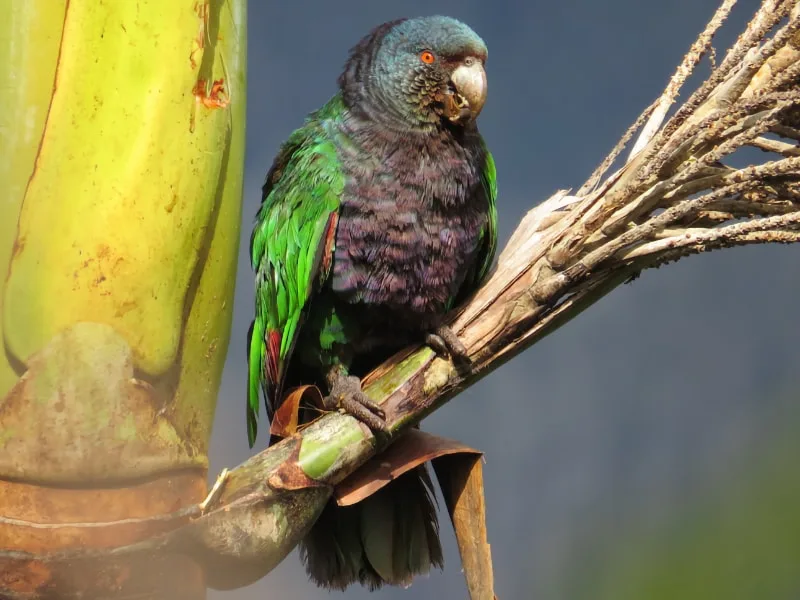
The imperial amazon is Dominica’s national bird, featuring prominently on the country’s flag and coat of arms. It is the largest parrot in its genus, distinguished by its striking green and purple plumage and its dependence on high-altitude rainforests. The species primarily inhabits remote mountainous regions between 600 and 1,300 meters, descending only occasionally in search of food. Due to its rarity and symbolic status, the imperial amazon is a flagship species for conservation efforts in Dominica.
Despite its cultural significance, the imperial amazon is critically endangered, with fewer than 50 mature individuals remaining. Its biggest threats include deforestation, habitat fragmentation, illegal capture for the pet trade, and hurricanes. Severe storms, such as Hurricane David in 1979 and Hurricane Maria in 2017, devastated much of Dominica’s forests, further pushing the species to the brink. Conservation initiatives focus on habitat protection, law enforcement against poaching, and monitoring programs, but without continued efforts, the future of this rare parrot remains uncertain.
Akikiki (Oreomystis bairdi)
- Conservation status: Critically Endangered.
- Estimated population: 5 to 10 individuals in the wild, as of 2023.
- Known range: Kaua’i, Hawaii.
- Main threats: Avian malaria, habitat loss, predation by invasive species.

The akikiki, also known as the Kaua’i creeper, is a small, insectivorous honeycreeper endemic to the island of Kaua’i. It inhabits the high-elevation rainforests of Koke?e State Park and the Alaka’i Wilderness Preserve, where it forages along tree trunks and branches, feeding on insects and spiders. Measuring about five inches in length, it has grayish-brown upperparts, whitish underparts, and a distinctive short tail. Once found across the island, its range has drastically shrunk due to habitat degradation and disease.
The akikiki is on the brink of extinction, with fewer than five individuals remaining in the wild as of 2023. Its primary threats include avian malaria, transmitted by invasive mosquitoes, habitat destruction, and predation by introduced rats. Climate change has worsened the situation by allowing mosquitoes to spread to higher elevations. Conservation efforts focus on captive breeding and habitat protection, with organizations such as the San Diego Zoo Wildlife Alliance working to prevent the species’ total extinction. Despite these efforts, the future of the akikiki remains uncertain.
Ivory-billed woodpecker (Campephilus principalis)
- Conservation status: Critically Endangered.
- Estimated population: Fewer than 20 individuals.
- Known range: Southeastern United States (historically), Cuba.
- Main threats: Deforestation, habitat loss.

The ivory-billed woodpecker once inhabited extensive bottomland hardwood forests across the southeastern United States and Cuba. However, large-scale logging and habitat destruction in the late 19th and early 20th centuries led to a steep decline. By 1944, the last widely accepted U.S. sighting occurred in Louisiana. In Cuba, credible reports continued into the 1980s, but no definitive proof has emerged. Given the lack of verified records, many ornithologists consider it functionally extinct.
In 2004-2005, a team of ornithologists reported a sighting in the Cache River and White River National Wildlife Refuges in Arkansas. They captured a brief video and recorded knocking sounds, which they attributed to the ivory-bill. However, these claims remain controversial, and extensive follow-up searches have failed to produce indisputable evidence. In 2021, the U.S. Fish and Wildlife Service proposed declaring the species extinct, but debates over its possible survival continue, with ongoing searches in remote swamp habitats. If the species still survives, spotting one would be an incredible stroke of luck, as no widely accepted photographic or physical evidence has emerged in decades.
Conclusion
At Planet of Birds, we have been documenting and following the status of North America’s rarest birds for nearly four decades. Through habitat loss, climate change, and conservation efforts, we have witnessed the challenges these species face, as well as the successes of dedicated conservation programs. While some birds remain on the brink of extinction, others have shown hopeful signs of recovery thanks to sustained efforts. By raising awareness and supporting science-based conservation, we remain committed to protecting these birds and ensuring their survival for future generations.
